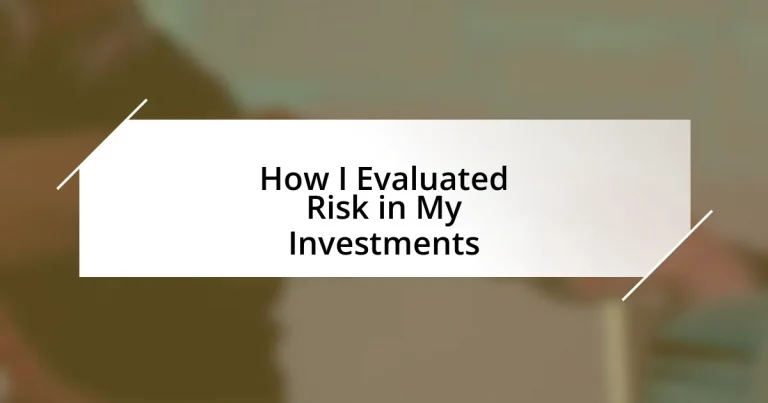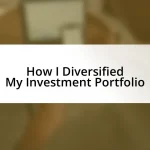Key takeaways:
- Understanding and distinguishing between systematic and unsystematic risks enhances investment decision-making and emotional readiness for potential losses.
- Utilizing risk assessment tools, like Value at Risk (VaR) and stress testing, empowers investors to make informed decisions and prepare for market volatility.
- Developing a diversification strategy across various asset classes and sectors helps mitigate risk and adapt to diverse economic conditions.
- Setting specific personal investment goals aligns investments with lifestyle choices, fostering focus and resilience during market downturns.
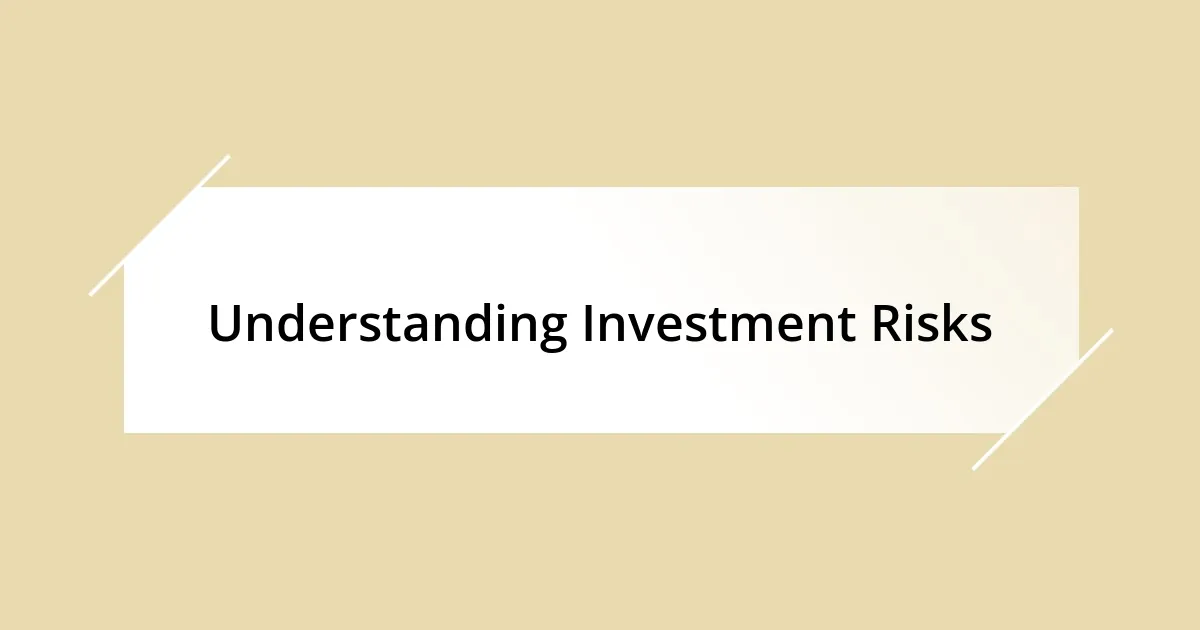
Understanding Investment Risks
Understanding investment risks is crucial for anyone looking to secure their financial future. I remember my first investment—an enthusiastic dive into tech stocks—where I quickly learned that the promise of great returns often comes with significant volatility. Just like a thrilling rollercoaster ride, the ups and downs can be exhilarating, but it’s vital to stay strapped in and prepared for sudden drops.
Investing in the stock market, for instance, means grappling with market risk, which can stem from economic changes, geopolitical events, or even shifts in investor sentiment. As I navigated my portfolio, I often found myself asking, “Am I emotionally ready for the potential loss?” This self-check proved vital; understanding that my emotions could cloud judgment was a turning point in my investment journey. It’s not just about numbers—it’s about your comfort level with uncertainty.
Moreover, I learned to recognize the difference between systematic and unsystematic risks. Systematic risk is like the tide affecting all boats, while unsystematic risk is more individual, affecting only specific stocks or sectors. Reflecting on my early choices, identifying and mitigating these risks transformed my approach. It made me realize that while I can’t control market fluctuations, I can definitely control how I respond to them.

Identifying Different Types of Risks
Identifying different types of risks has been a significant part of refining my investment strategy. Each risk presents a unique challenge, and it’s important to understand their nuances. During my early investments in real estate, I faced unexpected market shifts that taught me how crucial it is to be aware of both external and internal risks. The feeling of uncertainty during that time was palpable, but it pushed me to become more vigilant and informed.
Here are some key types of risks to consider:
-
Market Risk: This is the risk of changes in market prices that can affect the value of investments. I felt this firsthand when the market dipped unexpectedly, and I had to reassess my holdings.
-
Credit Risk: The risk that a bond issuer may default on their payment. When I invested in corporate bonds, I always checked the issuer’s credit rating to gauge this risk.
-
Liquidity Risk: The risk that an investment cannot be sold quickly without a substantial loss in value. I learned this when I faced difficulties selling a property during an economic slump.
-
Interest Rate Risk: The risk of bond prices falling as interest rates rise. I’ve watched my bond portfolio’s value fluctuate due to shifts in interest rates, reminding me of the delicate balance in investments.
-
Operational Risk: The risk arising from internal processes, people, or systems failing. I’ve had to navigate this when investing in startups whose operational efficiency was untested.
By categorizing these risks, I’ve learned to tackle each one more effectively, ultimately enhancing my investment experience.
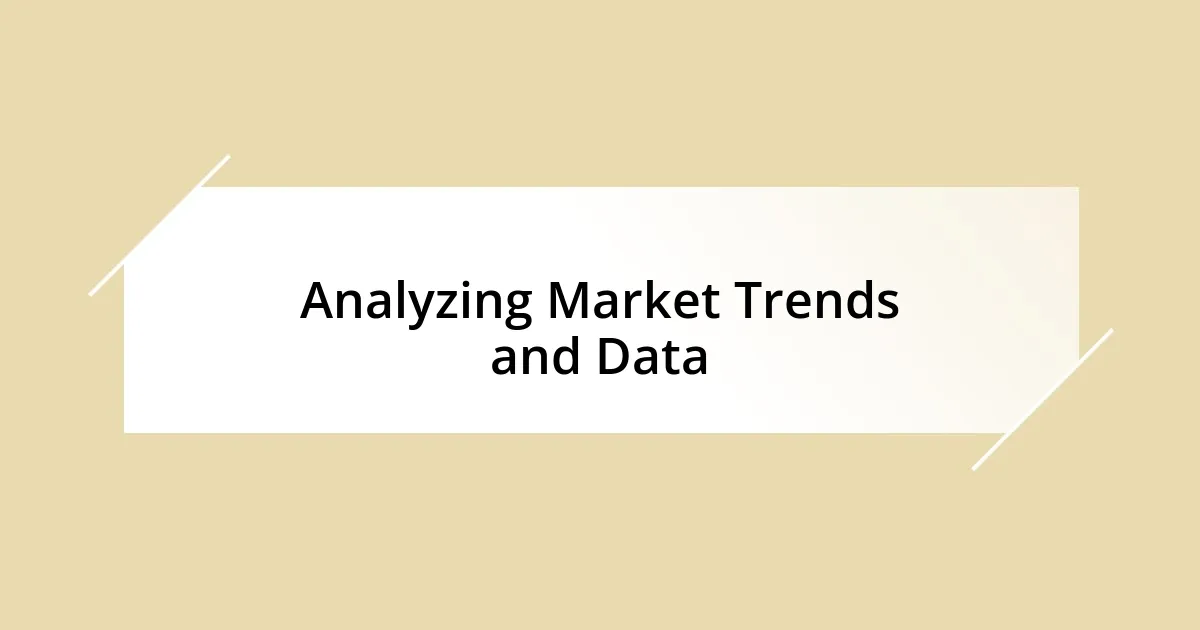
Analyzing Market Trends and Data
Analyzing market trends and data has become an essential practice in my investment approach. I’ve found that closely monitoring patterns not only reveals potential opportunities but also signals underlying risks. For instance, during a period when market sentiment shifted sharply due to regulatory changes, I recall feeling a mix of anxiety and determination. This experience taught me the power of data analysis; I was able to pivot my strategy by diving into trend reports and identifying which sectors remained resilient even amidst turbulence.
In my experience, examining economic indicators can be a real game-changer. I often refer to metrics like unemployment rates, inflation, and consumer spending to gauge the overall market health. Just last year, when I noticed a steady increase in unemployment rates, I felt a sense of urgency to reassess my investments in consumer retail. It’s astonishing how a slight downturn in one sector can ripple through others. Data-driven insights help me stay one step ahead, and it’s thrilling to watch the strategies unfold in real-time based on these trends.
| Market Trend | Response Strategy |
|---|---|
| Increasing Unemployment Rates | Diversify into Defensive Stocks |
| Rising Inflation | Invest in Commodities |
| Positive Earnings Surprises | Increase Holdings in Growth Stocks |
One of my favorite analytical tools is the use of moving averages. I remember using the 50-day and 200-day moving averages to assess the momentum of various stocks. There was an exhilarating moment when I noticed a stock I had invested in crossed above its 200-day moving average, signaling a strong upward trend. I felt a wave of excitement and relief, knowing my attention to detail paid off. This kind of technical analysis not only gives insights into price patterns but also builds my confidence in decision-making. I often reflect on how these small moments of discovery can lead to greater financial certainty, making the often overwhelming world of investing feel a bit more manageable.

Utilizing Risk Assessment Tools
Utilizing risk assessment tools is like having a safety net in the unpredictable world of investing. I often turn to software platforms that quantify risk, helping me visualize potential downfalls. For example, I remember using a risk assessment tool to evaluate my portfolio’s exposure to volatility. The insights were eye-opening! It was fascinating to see how certain assets performed under different market conditions and how I could adjust my strategy accordingly.
One of my go-to tools is the Value at Risk (VaR) metric. It helps me estimate the potential loss I might face under normal market conditions, which gives me a sense of control. I once ran a VaR analysis that showed my tech stocks were riskier than I anticipated. I felt a pang of concern—but it pushed me to be proactive, diversifying my holdings to mitigate that risk. Isn’t it interesting how a little data can shift your perspective so dramatically?
I’ve also explored stress testing, a method where I simulate extreme market scenarios to see how my investments might hold up. I distinctly recall testing my portfolio against previous market crashes. The process was nerve-wracking, yet enlightening; I realized some investments were more vulnerable than I thought. This kind of foresight empowers me to make informed decisions and bolster my confidence during turbulent times. After all, isn’t preparation one of the best ways to navigate uncertainty?
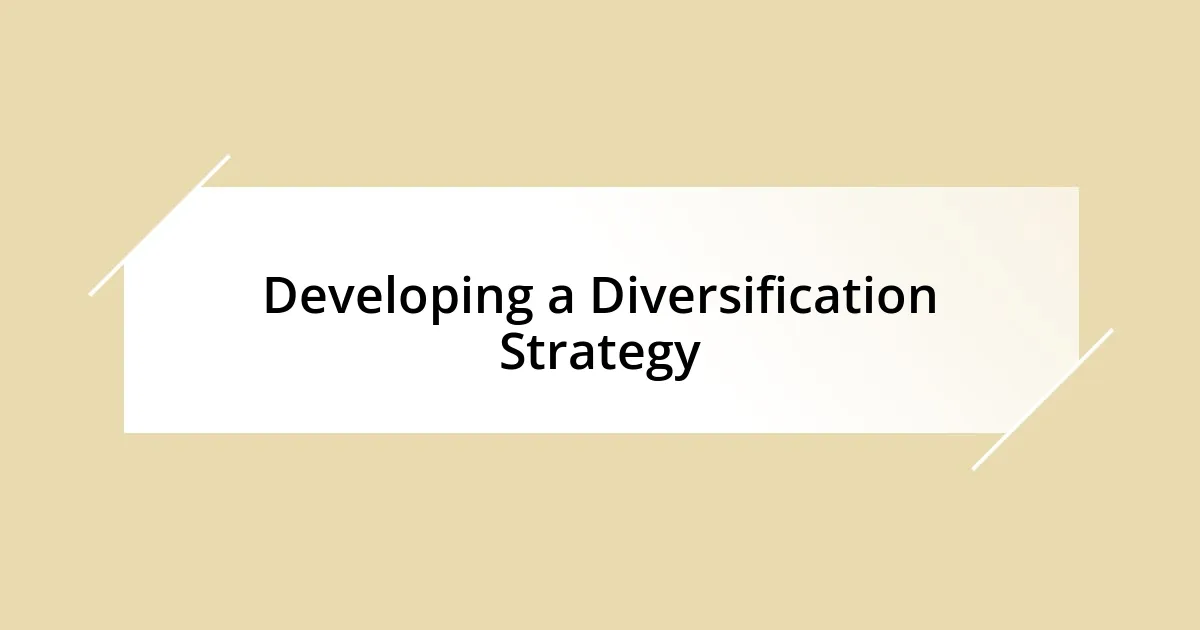
Developing a Diversification Strategy
When developing a diversification strategy, I’ve learned it’s crucial to spread my investments across various asset classes. For instance, I once felt overly confident after a string of successes in tech stocks. However, watching the sector tumble due to regulatory concerns made me realize the importance of balancing risk. Now, I allocate my portfolio among equities, bonds, and even real estate. This strategy not only cushions me during downturns but also invites growth from different sources.
I remember a time when I decided to dip my toes into international markets. Initially, I hesitated, fearing the unknown, but viewing it as a way to diversify made me take the plunge. The experience has been rewarding. I’ve witnessed emerging markets thrive while other sectors lag, reinforcing my belief that a well-rounded portfolio can adapt to diverse economic landscapes. Have you ever felt that thrill of venturing into a new market? It can truly pay off.
Additionally, I’ve found that not all diversification strategies are created equal. One lesson I took to heart was to differentiate not just by assets, but also by sectors and styles—value versus growth, for example. When I started incorporating more defensive stocks during periods of uncertainty, there was a level of reassurance that came with it. The ability to lean on various asset types during volatility helps ease my anxiety and keeps me engaged, creating a sense of stability I cherish.

Setting Personal Investment Goals
Setting personal investment goals is one of the foundational steps I undertake in my investment journey. I often find that taking the time to define what I want to achieve helps me stay focused and motivated. For instance, when I decided I wanted to save for a home, I set a specific target amount and timeline. This clarity not only guided my investment choices but also kept my spending habits in check.
I remember feeling overwhelmed by the sheer volume of investment options available. It was at that point I realized I needed to align my investments with my lifestyle goals. By categorizing investments into short-term and long-term priorities, I was able to allocate resources more effectively. Have you ever felt torn between different financial objectives? Establishing distinct goals truly helps to prioritize what matters most.
One insightful moment was when I shifted my mindset from simply wanting to grow my wealth to aiming for financial independence. I mapped out my goals not just by numbers, but by the freedom they represented—travel, spending more time with family, and pursuing passions. This deep emotional connection to my goals allowed me to look at downturns with a sense of resilience. Isn’t it amazing how clarity in your aspirations can transform your approach to investing?
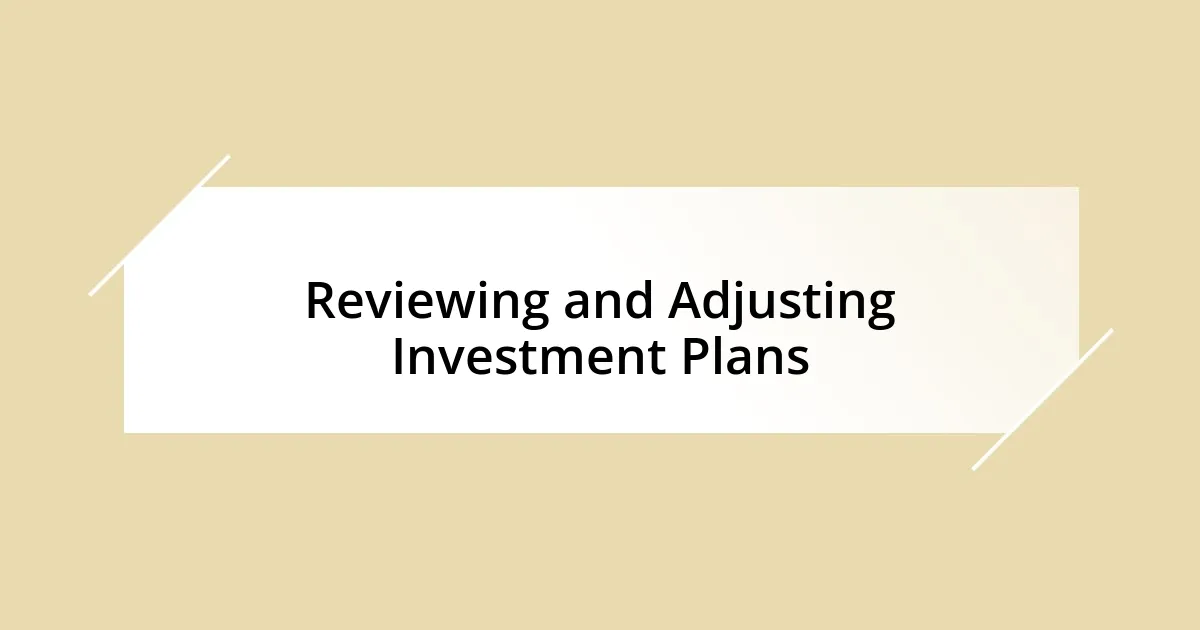
Reviewing and Adjusting Investment Plans
Reviewing my investment plans is like checking the pulse of my financial health. I revisit my portfolio quarterly, analyzing which investments align with my goals. Once, I noticed one of my favorite funds underperforming and instead of clinging to nostalgia, I swiftly redirected those funds to a sector showing promise. It was a difficult decision at first, but ultimately reinforced the necessity of staying dynamic.
Adjustments often come from reflecting on life changes. When I got married, my priorities shifted, and so did my risk appetite. It wasn’t just about growth anymore; I needed stability for our family. This realization led me to incorporate more conservative investments, which softened the impact of market volatility. Have you ever had to recalibrate your financial plans? It’s a jarring but essential process that can redefine your journey.
Additionally, I value feedback from trusted advisors when I reassess my strategies. During one such discussion, I was encouraged to consider a more global perspective, prompting me to explore opportunities in sustainable investments. This insight sparked a passion for socially responsible investing. I now ask myself regularly: how can I make my money work not just for me, but also for the world? These conversations have been an eye-opener, nurturing growth in my approach to investment planning.












